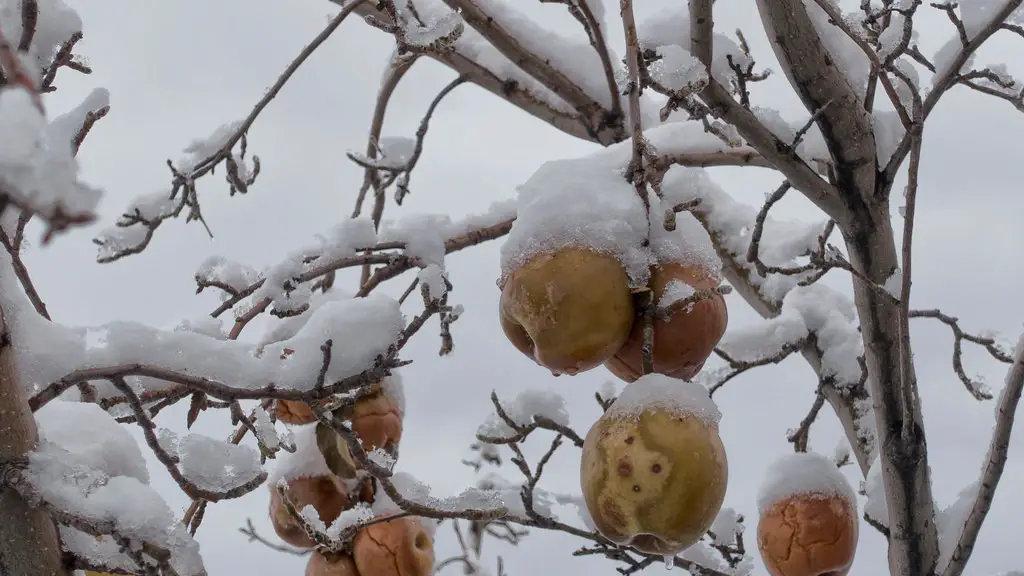It is possible to determine the answer to the question of how long it takes an apple tree to bear fruit typically by considering some of the various factors involved in the process. While the precise timeline can vary, it usually takes an apple tree three to five years before producing fruit after being planted. The main influencing factors behind how long it takes an apple tree to produce fruit include the species, the quality of the soil, weather conditions, and adequate maintenance practices.
Certain varieties of apple tree require more time to bear fruit compared to others, with some species taking as long as eight to ten years. For example, apple trees of the Honeycrisp variety, tend to require more time than other varieties such as Golden Delicious, which may only take three to four years or less from planting to fruiting.
Additionally, the quality of the soil can heavily influence how long it takes for an apple tree to bear fruit. For instance, soil with a high clay content will be much harder for the apple tree to absorb its necessary nutrients from, and can then interfere with the tree’s production of fruit. For optimum growth, an apple tree should be planted in well-draining soil with a neutral to slightly acidic pH level.
Favorable weather conditions can also make a significant difference in how long it takes an apple to fruit. If a tree is located in an area that receives inadequate sun exposure or is overly wet, the apple tree’s development process may be hampered. Temperatures during the winter can also be critical; if temperatures reach below the minimum that the species of apple tree is compatible with, this may cause a significant delay in the fruiting process.
Adequate maintenance is also key to ensuring that an apple tree fruits as expected. Watered as needed and fertilized twice a year, in the spring and autumn, can greatly aid the tree’s development. Additionally, apple trees should be pruned periodically, with the heaviest of the pruning occurring once it has reached fruiting maturity.
Maintenance Practices
Considering maintenance practices is essential to determining how long it takes an apple tree to fruit. Generally, apple trees require adequate watering and fertilization, as well as regular pruning for optimal results. An apple tree should receive a thorough watering once a week during hot dry months and twice a week during hotter summer months. Watering should be done in the early morning as this allows ample time for the tree to absorb the moisture, while also avoiding evaporation.
Fertilization helps in the growth of healthy apple trees, and while they don’t need to be fertilized every month, regular fertilization is still beneficial. Fertilization should be done during late winter or early spring when the tree is still in a dormant state, as well as mid-season in the early to mid-summer months, when the tree is in full flush. An 8-2-4 fertilizer is generally recommended, as long as it’s tailored to the soil pH.
Finally, apple trees require pruning, which removes dead or diseased branches, as well as thinner branches that are competing for sun and nutrition. Pruning is important for allowing adequate air circulation for the tree, optimizes its structure, and facilitates an increase in the number of blooms each year, eventually leading to a larger yield of fruit. While light pruning can be done year-round, it is best to wait until the tree is two or three years old to begin heavy pruning.
When all of these various factors are taken into consideration, it typically takes an apple tree three to five years to bear fruit, depending on the species of the tree and the various environmental conditions in which it is planted. Maintenance practices such as regular watering and fertilization can also help to speed up the process, as can proper pruning when the tree begins reaching maturity.
Harvesting
Once apple trees reach the appropriate maturity, it can take an additional three to four months from blooming to harvesting. Knowing when to harvest apples depends on the maturity of the fruit, its color, size, and firmness. For most apple varieties, apples will be ready to be picked when they reach a golden-red hue and are easily detachable from the tree. Apples also typically become more aromatic and will give off a slight “snap” sound when they are ready to be picked.
When picking apples, it is important to gently twist them to ensure maximum ripeness and to prevent the stem from breaking. Fruits that are easily twistable should be immediately placed in cool storage, as this will prevent them from over-ripening and rotting quickly. Apples may also need to be thinned out, meaning that one out of every four to six apples is removed from the tree in order for the remaining apples to grow with ample space.
Finally, harvesting of apples needs to be done in light of the predicted weather conditions. It is not advisable to pick apples when rain is expected, as this can lead to the fruits becoming overly soft or splitting. Apples picked in wet weather also tend to lack firmness and may cause them to go bad more quickly.
Generally, apple trees require around three to five years to reach maturity and to bear fruit, although certain varieties may take longer, while others may be ready sooner. Proper maintenance practices, such as fertilization and pruning, as well as favorable environmental conditions, all contribute to the amount of time it takes for an apple tree to bear fruit. Once apples are ready to be picked, it then takes between three to four months for them to fully mature and ripen.
Uses for Unripe Apples
In the months leading up to when apples have fully ripened and are ready for harvesting, there are still ways to utilize unripe apples. Unripe apples, or those that are tart and granny smith-like, are perfect for making different dishes. One popular use for such apples is for making apple sauce, and it is possible to add different spices to create various types of sweet and savory sauces.
Furthermore, green apples are also great for making an apple pie, as they are less sweet but still provide a great flavor. Baking unripe apples also helps to release their natural sugars, providing a great way to sweeten any type of pie recipe. Additionally, unripe apples can also be used as a flavor-infusing agent for cooking various meats, such as pork and chicken. Apples also go great with fish and can easily be added to slaws and other cold dishes.
Apples can also be stored for future use long before it is time for them to be harvested. This is done by placing them into a cool and dark place, such as a root cellar, in a state of rest, or dormancy. This helps to retain the apple’s crunchy flesh and tart flavor, allowing them to last for an extended period of time without spoiling.
In summary, it typically takes an apple tree three to five years before it is ready to bear fruit. However, by utilizing proper maintenance practices, as well as planting in favorable environmental conditions and species-appropriate soil, this timeline can be shortened. Moreover, unripe apples can be utilized in various recipes, such as apple sauce, pies, and different types of dishes, while they can also be stored to be enjoyed at a later date.
Apple Tree Preservation
Preserving apple trees is essential for longevity and practicality and it is key to ensure that an apple tree continues to fruit reliably each year. When apple trees are faced with untimely damage or diseases, the lifespan of the tree is significantly decreased, and it may no longer bear fruit reliably or have enough leaves or blossoms to provide shade and decoration. Therefore, preventive care practices should always be in place when it comes to preserving apple trees.
Regular maintenance practices such as watering, fertilizing, and pruning should remain routine, as these all influence the health and production of the tree. In addition to these practices, it is important to undertake preventive care measures such as battling insect infestations and engaging in effective management of any fungal or bacterial diseases.
The type of soil the apple tree is planted in is also important, and replacement of the original soil may be necessary if the tree is showing signs of unhealthy development. Planting the tree in an environment-specific soil mix will assist in providing the tree with the correct balance of nutrients, while also helping to provide the necessary drainage for appropriate development.
Furthermore, attention should also be paid to any nearby competing root systems. Roots from nearby plants can compete with the nutrients and water of an apple tree, significantly impeding its development. Additionally, it is generally recommended to use a tree cover to protect the trunk and leaves of an apple tree during the winter months, as extreme conditions can damage the buds and blossoms of the tree.
Generally, apple trees take three to five years to bear fruit, although this timeline may vary depending on specific conditions. Proper maintenance practices should always be employed to ensure that the tree remains healthy and continues to bear fruit reliably, while preventive care measures should also be taken to protect the tree from damage and diseases throughout the year. By following these practices, apple trees can be preserved and will maintain their productivity.




